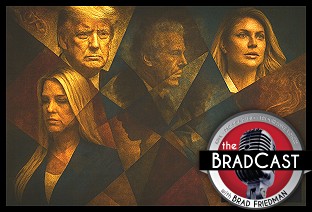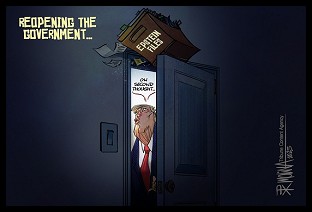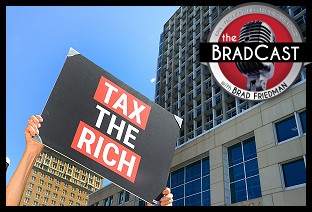 The May 3 article that appeared in UCLA's campus newspaper, the Daily Bruin, was disturbing but not surprising. The LAPD stood idly by as a group of "tear gas" wielding, pro-Israel "counter-protesters" violently attacked a pro-Palestine protest encampment. The attack reportedly went on for nearly four hours before the LAPD moved in, not to stop counter-protester violence, but to breakup the encampment.
The May 3 article that appeared in UCLA's campus newspaper, the Daily Bruin, was disturbing but not surprising. The LAPD stood idly by as a group of "tear gas" wielding, pro-Israel "counter-protesters" violently attacked a pro-Palestine protest encampment. The attack reportedly went on for nearly four hours before the LAPD moved in, not to stop counter-protester violence, but to breakup the encampment.
In a formal Statement, staff members of the UCLA History Department noted:
The history professors chastised both University of California administrators and the LAPD for their "disregard" for "students' safety and their right to express their views."
The professors weren't the only ones to express concern for law enforcement's failure to intercede as pro-Israel "counter protesters" violently attacked the encampment. California's Democratic Gov. Gavin Newsom, according to the Los Angeles Daily News, "called for investigations into [why the] pro-Israeli counter-protesters' attack...was allowed to rage for several hours with little to no police intervention."
Sadly, the story, as recounted by the Daily Bruin and the UCLA history professors, is on the continuum of well over a century of right-wing bias on the part of local, state and federal law enforcement against those who exercise First Amendment rights to engage in non-violent strikes or in peaceful, anti-war, environmental, and civil rights protests....
Class bias
On far too many occasions over the last half of the 19th Century and first half of the 20th Century, police violence was utilized to suppress the aspirations of the U.S. working class.
In some instances, like the 1897 Lattimore Massacre, xenophobia, as well as class, may have been a motivating factor. In that instance, Luzerne County PA Sheriff Deputies opened fire on striking, mostly immigrant coal miners who were marching in support of higher wages. Nineteen miners were killed and 38 injured.
The role of class bias was not confined to local law enforcement.
Near the end of the Hoover Administration, federal troops, under General Douglas MacArthur's command, used tanks, armed troops and bayonets in Washington DC to break-up an encampment of World War I veterans seeking to collect on bonus certificates.
Police violence, as a form of union-busting, began to recede in 1935 in the aftermath of union protections afforded by the National Labor Relations Act. But passage of the NRLA did not bring an end to class-motivated episodes of "extraordinary police violence" --- a point we covered throughout the Occupy Wall Street movement.
Anti-war and environment
The protests at UCLA could accurately be described as "anti-war".
Throughout the 1960's and '70's, those who engaged in peaceful protests against the Vietnam War were regularly subjected to police violence. Two of the more notable events entailed what would be dubbed a "police riot" when the Chicago PD violently attacked anti-war demonstrators outside the Democratic National Convention in 1968 and the Kent State massacre, where, on May 4, 1970, the National Guard opened fire, killing four students.
There are, of course, multiple examples of violent police assaults on environmental protesters, one, a 2016 attack on those protesting the Dakota Access pipeline, should serve as a reminder.
Race
The failure of the LAPD to intercede while the UCLA anti-war demonstrators were violently attacked calls to mind one of the darker chapters in U.S. history.
In May 1961, knowing full well that an angry KKK-led white mob planned to attack two busses carrying Freedom Riders during the civil rights movement, Bull Connor, Birmingham, Alabama's Public Safety Commissioner, used Mother's Day as a supposed reason why no police would be present when the busses arrived at Birmingham's Greyhound Station. The first bus was stopped near Anniston, AL when its tires were blown out. A bomb, thrown on the bus, burst into flames. The escaping Freedom Riders were brutally beaten, as were the Freedom Riders on the second bus when it arrived in Birmingham.
The LAPD decision, after failing to protect the pro-Palestine demonstrators, to storm the otherwise peaceful encampment also had a 1961 antecedent: the arrest of John Lewis and hundreds of other civil rights-era Freedom Riders in Jackson, MS. Lewis, et al., were "hastily convicted of breach of the peace", according to The New York Times, which added: "Many of the Freedom Riders spent six weeks in prison, sweltering in filthy, vermin-infested cells."
The instances of mid-twentieth century, race-based police violence against peaceful civil rights protesters are far too numerous to recount. And while the police violence unleashed upon peaceful marchers by AL state troopers on Bloody Sunday, March 17, 1965, has been credited for the passage of the Voting Rights Act of 1965, the race-based disparity in the application of police violence has continued.
For example, in a 2018 Salon article, Brad Friedman noted the stark contrast between the application of force by "militarized police" in the "tear-gas filled streets" of Ferguson, MO with the kid gloves approach to a heavily armed right wing group during a stand-off occasioned by "scofflaw" Nevada rancher, Clive Bundy, who "refused", over the course of twenty-years, to pay grazing fees for use of public lands he did not own.
The LAPD failure to intercede when the UCLA protest encampment was attacked also calls to mind the occasion in August 2017, when, according to Pro Publica, state police and the Virginia National Guard "watched passively for hours as self-proclaimed Nazis", many sporting body armor and assault rifles, attacked counter-protesters in Charlottesville, VA. (Unlike UCLA, some of the anti-Nazi Charlottesville counter-protestors fought back, using pepper spray.)
Where, in 2020, National Park Police and the National Guard staged an unprovoked attack on peaceful Black Lives Matter demonstrators in service of a Donald Trump photo-op near the White House, the members of armed right-wing mobs faced neither resistance nor legal consequences when they invaded and occupied State Capitols in Idaho and Michigan.
Eventually, more than 1,230 members of the right-wing insurrectionist mob that stormed the U.S. Capitol on Jan. 6, 2021 would be charged with federal crimes, but only a handful of the insurrectionists were arrested inside or outside the Capitol building on Jan. 6.
The behavior of police at UCLA was appalling. But, unfortunately, it was not a surprise.
UPDATE 5/17/24: A more in-depth analysis of the paradox of police power is provided by the Netflix film, "Power".
 Ernest A. Canning is a retired attorney, author, and Vietnam Veteran (4th Infantry, Central Highlands 1968). He previously served as a Senior Advisor to Veterans For Bernie. Canning has been a member of the California state bar since 1977. In addition to a juris doctor, he has received both undergraduate and graduate degrees in political science. Follow him on twitter: @cann4ing
Ernest A. Canning is a retired attorney, author, and Vietnam Veteran (4th Infantry, Central Highlands 1968). He previously served as a Senior Advisor to Veterans For Bernie. Canning has been a member of the California state bar since 1977. In addition to a juris doctor, he has received both undergraduate and graduate degrees in political science. Follow him on twitter: @cann4ing


 Trump's Terrible, Horrible,
Trump's Terrible, Horrible, 'Green News Report' 11/18/25
'Green News Report' 11/18/25
 A Kaleidoscope of Trump Corruption: 'BradCast' 11/17/25
A Kaleidoscope of Trump Corruption: 'BradCast' 11/17/25  Sunday 'Back to Business' Toons
Sunday 'Back to Business' Toons Trump DOJ Takes Stand
Trump DOJ Takes Stand 'Green News Report' 11/13/25
'Green News Report' 11/13/25 Mamdani's 'Surprisingly Affordable' Afford-ability Agenda for NYC: 'BradCast' 11/12
Mamdani's 'Surprisingly Affordable' Afford-ability Agenda for NYC: 'BradCast' 11/12 After the Shutdown and Before the Next One: 'BradCast' 11/11/25
After the Shutdown and Before the Next One: 'BradCast' 11/11/25 'Green News Report' 11/11/25
'Green News Report' 11/11/25 Victories for Democracy in Election 2025; Also: 7 Dems, 1 Indie Vote to End Shutdown in Senate: 'BradCast' 11/10/25
Victories for Democracy in Election 2025; Also: 7 Dems, 1 Indie Vote to End Shutdown in Senate: 'BradCast' 11/10/25 Sunday 'Ass Kicking' Toons
Sunday 'Ass Kicking' Toons 'We Can See Light at the End of the Tunnel' After Election 2025: 'BradCast' 11/6/25
'We Can See Light at the End of the Tunnel' After Election 2025: 'BradCast' 11/6/25 'Green News Report' 11/6/25
'Green News Report' 11/6/25 BLUE WAVE! Dems Win Everything Everywhere All at Once: 'BradCast' 11/5/25
BLUE WAVE! Dems Win Everything Everywhere All at Once: 'BradCast' 11/5/25 Repub Thuggery As Americans Vote: 'BradCast' 11/4/25
Repub Thuggery As Americans Vote: 'BradCast' 11/4/25 Last Call(s) Before Election Day 2025: 'BradCast' 11/3/25
Last Call(s) Before Election Day 2025: 'BradCast' 11/3/25 A Pretty Weak 'Strongman': 'BradCast' 10/30/25
A Pretty Weak 'Strongman': 'BradCast' 10/30/25 Proposal for 'Politically Viable Wealth Tax' Takes Shape in CA: 'BradCast' 10/29
Proposal for 'Politically Viable Wealth Tax' Takes Shape in CA: 'BradCast' 10/29 Monster Storm, Endless Wars, Gamed Elections: 'BradCast' 10/28/25
Monster Storm, Endless Wars, Gamed Elections: 'BradCast' 10/28/25 Let's Play 'Who Wants to Be a U.S. Citizen?'!: 'BradCast' 10/27/25
Let's Play 'Who Wants to Be a U.S. Citizen?'!: 'BradCast' 10/27/25 Exiled NOAA Scientists Resurrect Critical Disaster Database: 'BradCast' 10/23/25
Exiled NOAA Scientists Resurrect Critical Disaster Database: 'BradCast' 10/23/25
 VA GOP VOTER REG FRAUDSTER OFF HOOK
VA GOP VOTER REG FRAUDSTER OFF HOOK Criminal GOP Voter Registration Fraud Probe Expanding in VA
Criminal GOP Voter Registration Fraud Probe Expanding in VA DOJ PROBE SOUGHT AFTER VA ARREST
DOJ PROBE SOUGHT AFTER VA ARREST Arrest in VA: GOP Voter Reg Scandal Widens
Arrest in VA: GOP Voter Reg Scandal Widens ALL TOGETHER: ROVE, SPROUL, KOCHS, RNC
ALL TOGETHER: ROVE, SPROUL, KOCHS, RNC LATimes: RNC's 'Fired' Sproul Working for Repubs in 'as Many as 30 States'
LATimes: RNC's 'Fired' Sproul Working for Repubs in 'as Many as 30 States' 'Fired' Sproul Group 'Cloned', Still Working for Republicans in At Least 10 States
'Fired' Sproul Group 'Cloned', Still Working for Republicans in At Least 10 States FINALLY: FOX ON GOP REG FRAUD SCANDAL
FINALLY: FOX ON GOP REG FRAUD SCANDAL COLORADO FOLLOWS FLORIDA WITH GOP CRIMINAL INVESTIGATION
COLORADO FOLLOWS FLORIDA WITH GOP CRIMINAL INVESTIGATION CRIMINAL PROBE LAUNCHED INTO GOP VOTER REGISTRATION FRAUD SCANDAL IN FL
CRIMINAL PROBE LAUNCHED INTO GOP VOTER REGISTRATION FRAUD SCANDAL IN FL Brad Breaks PA Photo ID & GOP Registration Fraud Scandal News on Hartmann TV
Brad Breaks PA Photo ID & GOP Registration Fraud Scandal News on Hartmann TV  CAUGHT ON TAPE: COORDINATED NATIONWIDE GOP VOTER REG SCAM
CAUGHT ON TAPE: COORDINATED NATIONWIDE GOP VOTER REG SCAM CRIMINAL ELECTION FRAUD COMPLAINT FILED AGAINST GOP 'FRAUD' FIRM
CRIMINAL ELECTION FRAUD COMPLAINT FILED AGAINST GOP 'FRAUD' FIRM RICK SCOTT GETS ROLLED IN GOP REGISTRATION FRAUD SCANDAL
RICK SCOTT GETS ROLLED IN GOP REGISTRATION FRAUD SCANDAL VIDEO: Brad Breaks GOP Reg Fraud Scandal on Hartmann TV
VIDEO: Brad Breaks GOP Reg Fraud Scandal on Hartmann TV RNC FIRES NATIONAL VOTER REGISTRATION FIRM FOR FRAUD
RNC FIRES NATIONAL VOTER REGISTRATION FIRM FOR FRAUD EXCLUSIVE: Intvw w/ FL Official Who First Discovered GOP Reg Fraud
EXCLUSIVE: Intvw w/ FL Official Who First Discovered GOP Reg Fraud GOP REGISTRATION FRAUD FOUND IN FL
GOP REGISTRATION FRAUD FOUND IN FL

































